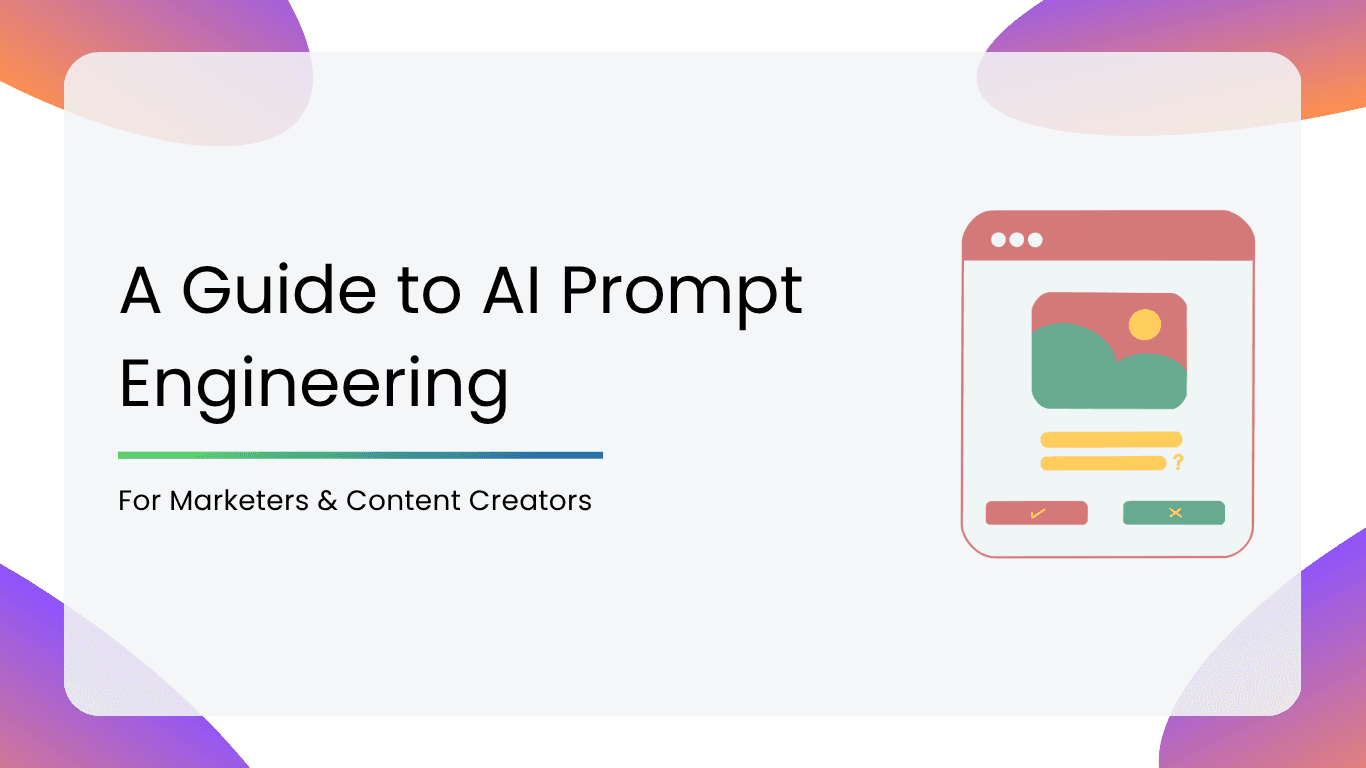If you’re a marketer or a content creator, you’ve probably already felt how AI is changing the way we work. AI tools are becoming everyday companions in our creative workflow.
But let’s also agree that not all AI outputs are created equal. You might end up with something that sounds very generic, flat, and not quite you. That’s where prompt engineering comes in.
The more clearly and creatively you prompt, the more valuable the results. In fact, good prompts help you turn AI into a true creative partner, not just a shortcut.
Let’s understand what prompt engineering is and how it can transform your creative process.
What is AI Prompt Engineering?
At its core, prompt engineering is about forming the right questions, instructions, or context to get the best possible output from AI tools.
Think of it like placing an order at a restaurant. If you just say “food,” the chef has no clue what you want. But if you say, “a grilled veggie sandwich with extra cheese, no onions, and toasted bread,” the chef knows exactly what you want.
The same logic applies to AI. The more specific, structured, and intentional your prompt, the more useful the response. So, next time, instead of saying:
“Write me a blog post on content marketing.”
Try:
“Write a 600-word blog post on content marketing trends in 2025, with examples from B2B brands, and a conversational tone suitable for LinkedIn.”
Why AI Prompt Engineering Matters for Marketers & Creators
Marketing and content creation move at lightning speed. One minute you’re writing a product description, the next you’re optimizing an email funnel or coming up with 20 ideas for trending reels. That’s exactly why prompt engineering matters.
AI tools are powerful, but without the right prompts, they can give results that feel and sound like a vague copy. Prompt engineering bridges this gap.
Here’s how it helps:
1. Faster Brainstorming, Better Output: Need a hook for your next campaign or ten email subject lines in under a minute? A well-thought-out prompt gets you there fast.
2. Consistent Brand Voice: By training your prompts to reflect tone, style, and audience, you can get AI to mimic your voice instead of sounding like a robot.
3. Less Rework: Instead of sitting through random responses and editing them endlessly, a strong prompt gets you closer to a publish-ready draft.
4. Smarter Use of AI: Prompt engineering lets you summarize data, rewrite for different personas, and repurpose long content into social media posts.
Key Elements of a Good AI Prompt
If you’ve ever felt like AI isn’t doing its job right, chances are the prompt needed a little tuning. Here are the core elements every solid prompt should have:
1. Instruction: What do you want the AI to do?
The rule is to be direct. Are you asking it to write, summarize, rewrite, analyze, ideate, translate, or do something entirely different? Start your prompt with an action verb so the AI knows exactly what task it’s performing.
“Write a list of Instagram captions for a skincare brand’s summer launch.”
2. Context: Who is this for? What’s the topic?
AI needs to know the why behind your request. Give it background on your audience, product, platform, or tone. The more context you provide, the more relevant and on-brand the result.
“The audience is Gen Z skincare lovers. Keep the tone playful and meme-like.”
3. Input Data: Are you feeding it examples or source content?
If you have a blog, testimonial, brief, or any reference content, drop it in. AI works even better when it has something to work with, not just a vague request.
“Here’s the original paragraph. Rewrite it to sound like Apple product copy.”
4. Output Format: What should the response look like?
Do you want a paragraph, a bullet list, or a table? Do you want it short, formal, poetic, sarcastic, or conversational? Tell it. The output format shapes how usable the response will be.
“Give me 5 bullet points with emojis. Each line under 100 characters.”
Popular AI Prompting Techniques
Once you’re familiar with a good prompt, it’s time to level up with some simple prompting techniques. Let’s explore four common techniques you can start using today, especially in your marketing and content workflows.
1. Zero-Shot Prompting
This is the simplest kind: no examples, just an instruction.
“Write 5 ad headlines for a new skincare brand targeting Gen Z.”
Perfect when:
- You’re in idea mode.
- You want quick outputs and can fine-tune later.
2. One-Shot Prompting
Now we’re adding one example so the AI gets an understanding of what you want.
“Here’s an example: ‘Glow up your skin routine naturally.’ Now write 5 more ad headlines for the same brand.”
Why it works:
- It subtly guides the tone or structure you’re looking for.
- Helpful when the first round of AI outputs feels off.
3. Few-Shot Prompting
Give the AI 2-3 examples and then ask it to continue.
“Example 1: ‘Glow up your skin routine naturally.’
Example 2: ‘Your skin’s new BFF, bottled.’
Example 3: ‘Skincare that actually listens to your skin.’
Now write 5 more headlines in the same style.”
Why it’s great:
- Perfect for maintaining brand tone and vibe.
- Helps when you want the output to feel cohesive and copy-ready.
4. Chain-of-Thought Prompting
Here, you’re guiding the AI step-by-step. It is great for planning and reasoning tasks.
“Help me plan a content calendar for a sustainable fashion brand. First, list 3 monthly themes. Then, suggest 2 content ideas for each. After that, recommend hashtags.”
Use this when:
- You’re working on strategy, research, or planning.
- You want AI to think in stages, not just produce a random list.
Each technique has its unique response. With just a bit of structure, you’ll start getting results that feel aligned with your brand and take way less time to tweak.
How Marketers & Content Creators Can Use AI Prompt Engineering
Here are some real-world ways marketers and content creators can use prompts in their day-to-day tasks:
1. Content Ideation
Are you stuck on what to post? You can prompt your way out of the creative block.
Do:
“Suggest 10 blog titles about eco-friendly skincare for Gen Z. Keep it playful and under 10 words each.”
Why it works: Clear audience, topic, tone, and format constraints.
Don’t:
“Can you give me some blog title ideas for skincare?”
Why it falls short: Slightly better than vague, but still missing the audience (Gen Z), tone (playful), and creative limits (e.g., word count). The output will be generic.
2. Audience Persona Building
Do you need a customer persona for a pitch or campaign? Just ask.
Do:
“Create a customer persona for a 30-something urban mom interested in clean beauty. Include goals, buying triggers, and content preferences.”
Why it works: Crystal clear demographic + behavior + output expectations.
Don’t:
“Make a skincare user persona for my campaign.”
Why it falls short: Who’s the persona for? What kind of skincare? No clarity on what to include (like goals, triggers, or content use).
3. Keyword Clustering
You can even carry out your SEO keywords research without having to engage in the spreadsheet method.
Do:
“Group these keywords into clusters for blog content: ‘best running shoes,’ ‘trail running tips,’ ‘running form,’ etc. Suggest one article idea for each cluster.”
Why it works: Provides specific keywords + a goal (clustering) + extra task (suggest articles).
Don’t:
“Help me group some SEO keywords for my running blog.”
Why it falls short: No actual keywords given, unclear whether we’re clustering for blogs, ads, or pages. The output will be vague or full of assumptions.
4. Brief & Outline Generation
If you need to prepare a blog, video, or carousel, let AI do all this.
Do:
“Write a creative brief for a blog titled ‘Top 5 Marketing Trends in 2025.’ Tone: professional yet casual. Format: intro + 5 sub-sections + conclusion.”
Why it works: Title, tone, structure… all nailed down.
Don’t:
“Can you write a brief for a marketing blog post?”
Why it falls short: No topic, no format or structure guidance, just opens the door to filler output that won’t match your vision.
5. Repurposing Content
You can turn one big piece of content into multiple micro-assets in a few prompts.
Do:
“Here’s a blog post. Create 3 tweets and 1 LinkedIn post summarizing its main points, each with a slightly different tone.”
Why it works: Includes output type, platform, tone variety, and objective (summary).
Don’t:
“Can you turn this blog into some social posts for me?”
Why it falls short: No clarity on platforms, formats, how many posts, or tone. Leaves too much room for irrelevant output.
Tips to Write Better AI Prompts
Here are a few quick tips to make your prompts actually work for you:
1. Be Clear & Specific
Vague prompts will always lead to vague responses. Always say what you want and how you want it.
“Write 5 punchy subject lines for a holiday sale email. Keep them under 50 characters and include a sense of urgency.”
2. Use Active Instructions
Focus on what you do want, not what you don’t.
“Make it sound human, friendly, and informal, like a conversation.”
3. Include Examples When Needed
Whenever you’re in doubt, show exactly the vibe you’re after.
“Here’s an example of a caption that worked well. Use a similar tone and write 3 new ones for this product.”
4. Iterate, Don’t Expect Perfection
Even the best prompts might need tweaking, and that’s normal.
“Can you rewrite that in a Gen Z tone with emojis?”
Prompting is a skill, and like any skill, it gets better the more you test things out, break your own patterns, and let curiosity lead the way.
Common Pitfalls to Avoid in AI Prompt Engineering
Prompting might seem simple, but a few common slip-ups can turn a great idea into a bland output. Here are a few mistakes to steer clear of:
1. Vague Prompts
If your prompt is loose, unclear, or open-ended, the AI will fill in, but not in the way you’d like.
“Write a 3-paragraph blog introduction on why consistency matters in social media strategy for small businesses.”
2. Ignoring Tone & Audience
Leaving out tone, demographic, or platform context often leads to flat, one-size-fits-all results.
“Write a fun, casual product description for Gen Z shoppers discovering our eco-friendly phone cases on Instagram.”
3. Not Verifying AI Output
AI can sound confident while getting facts wrong, misquoting data, or even confusing sources. Always give it a second look.
Pro Tip:
- Double-check stats, names, URLs, and quotes.
- If you’re using it for research, cross-reference with real sources.
Whether you’re brainstorming your next viral post, building an SEO plan, or turning a single blog into a multi-platform content campaign, the way your prompt makes all the difference. Because when you learn to prompt well, you’re not just saving time, but you’re scaling your creativity.
So go ahead and test a new format, add that tone note, tweak your wording. The future of marketing isn’t about man vs machine, it’s about man with machine. And now you’ve got the blueprint to lead the way.
Check out our other blogs on AI trends, tools, and creative workflows:
- Best AI SEO Tools & How to Use Them
- AI Search Optimization: Optimize Your Content to Rank in AI Search Results
- Best AI Keyword Research Tools in 2025
FAQs
A good prompt gives you output that’s on-topic, high-quality, and close to ready with minimal edits. If the AI response feels relevant, structured, and aligned with your goal (tone, length, format), you’re on the right track. Try being more specific or adding an example to guide the AI better.
Start by including tone, audience, and platform details in your prompt. For example:
“Write this in a confident, conversational tone for LinkedIn, targeting B2B marketers.”
You can also save well-performing prompts as templates and tweak them slightly per task. Over time, you’ll build a small library of reusable, tone-aligned prompts that keep things consistent.
Yes, especially if you copy/paste without editing. AI content can sometimes sound repetitive, generic, or even mimic phrasing from its training data. To avoid this:
– Always review and edit for originality and brand voice.
– Use tools like Grammarly or SEO plugins to check for duplication.
– Focus on editing unique insights or perspectives, even if the AI does all the work.
Start simple:
– Track time saved on content creation tasks.
– Compare engagement metrics before and after integrating AI-generated content.
– Log how many pieces you’re able to create, repurpose, or publish faster. You can also track team productivity, especially if AI allows your team to move from repetitive tasks to more strategic deliverables.
Over time, the ROI shows up in both speed and scale.





